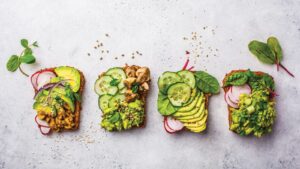The closure of restaurants and the stay-at-home orders that were enacted during the 2020 COVID-19 crisis have magnified the fact that many households are not cooking for themselves. Many families were eating takeout and convenience meals for the most part. In some cases they didn’t know how to cook, but in other cases it was because of excessive busy-ness. Some people have used this forced time at home as an opportunity to do more cooking from scratch.
I was a typical full-time working mother until twelve years ago. Breakfast was usually boxed cereal with milk. My normal lunch was a frozen Lean Cuisine meal with a Diet Coke. I sometimes prepared meals at home, but many days had a drive-through meal so that I could attend one of my children’s myriad activities.
Then, in the spring of 2008, I discovered I had multiple food allergies and sensitivities. The previous year I suffered with constant intestinal pain and headaches. Finally my doctor suggested I try an elimination diet. After a very short time I determined that I was highly sensitive to the gluten grains of wheat, rye, and barley. Later I learned I had celiac disease and was also allergic or sensitive to fish, pork, dairy, soy, corn, and other foods. My way of eating had to change completely overnight.
I reviewed the menus of the restaurants I had previously frequented. There was literally nothing I could eat from them. As I went through the aisles of my local grocery store the first few times, I teared up as I read the food labels. Canned soups had wheat, cereals were made with wheat or corn, salad dressings and mayonnaise were made with soybean oil. Sodas were filled with corn syrup. Cookies, bread, and cakes were made with wheat flour. Frozen dinners were made with wheat, milk, corn, soy, or all of these. What could I eat, I wondered?
Then it dawned on me to purchase only single ingredient foods. I could eat almost everything located in the produce section. I could have fresh beef, chicken, shellfish, and eggs. I could eat rice, quinoa, and gluten-free oats. I could eat nuts, seeds, most beans, and canned or frozen single fruits and vegetables. In short, with the exception of eliminating most grains and dairy, my diet would be very similar to what my grandmother would have eaten 100 years ago in 1920.
I learned to make meals from scratch. But I was still a full-time working mother and wife with no more time. Here are some of the strategies I have adopted over the years to make home cooking quick and simple.
1. Prepare food in bulk on Saturday or Sunday for the work week ahead.
There are many things you can do to make breakfasts and lunches quick and easy for the week. I boil a dozen eggs to take for breakfasts on the run or to use in salads. I often make a dozen almond or coconut flour muffins to eat with the eggs for breakfast. Since store bought salad dressings are almost always made with soybean oil, I make homemade dressings using olive or avocado oil, vinegar, and herbs. Finally, I cut up lettuce and various fresh vegetables and store them in a large covered dish to have fresh salad ready for my lunches.
2. Find recipes for quick and easy dinners.
I found recipes for meals that could be ready in 30 to 45 minutes using simple ingredients, often involving only one pot. Boneless chicken and ground beef can be used as the basis for numerous healthy dishes that can be prepared on the stovetop or in an Instant Pot. Try to develop a list of ten or more dinners that are relatively simple and nutritious.
3. Make a weekly meal plan and then shop for groceries.
Once you have your recipes ready, you can make a meal plan for the week, prepare your grocery list, and shop. By meal planning and shopping in advance, you have all of the ingredients ready to prepare your dinner for the evening in a short amount of time. Many families resort to takeout because they have not planned for dinner in advance. Since most restaurants are not an option for me, I adopted the habit of advanced meal planning.
4. Keep a running inventory of basic ingredients in your pantry, refrigerator, and freezer.
I keep a standard stock of vegetables in my freezer and also stock up and freeze meats when they are on sale. I also keep rice, garlic, onions, potatoes, sweet potatoes, canned beans, tomatoes, and coconut milk in my pantry as well as dried herbs and spices. With these ingredients on hand, it is relatively simple to make a quick and nutritious dinner even if you have not planned in advance.
5. Make double batches of most items so that you have leftovers.
Even though I cook almost all my meals from scratch, I do not need to cook full meals every day. My husband often takes leftovers from dinner for his lunch at work the next day. Our children are grown now, so most standard recipes will work for dinner two nights in a row.
6. Use pre-cut fresh produce.
Pre-cut produce is more expensive than whole produce, but can be a definite time saver. If you can afford it, purchase baby or shredded carrots, pre-cut lettuces, spiralized zucchini, riced cauliflower, and other pre-cut fruits and vegetables. This will save you preparation time throughout the week.
By adopting these suggestions, you can make healthy foods for your family without spending hours in the kitchen. Join me in discovering the joys of simple home cooking. Which step in this article can you start implementing this week?

























